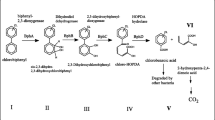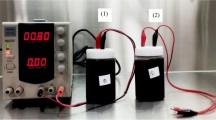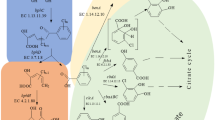Abstract
Literature review reveals that Persistent Organic Pollutants (POPs), such as polychlorinated biphenyls (PCBs), are electron deficient compounds due to the presence of highly electronegative groups. Hence, they are more amenable to anaerobic biodegradation rather than oxidative metabolism. However, the studies on PCBs bioremediation are more inclined towards aerobic treatment. Besides, the past studies are mainly centered on screening and application of PCB-degrading microorganisms. In our opinion the degradative capacity is already present in the native microflora, and choice of electron donor is of paramount importance for faster reductive metabolism of PCBs. In this study, the use of methanol as electron donor with cow dung as the general microbial inoculum resulted in high specific rate of degradation (0.0542–0.0637 /day) for high-chlorinated biphenyls. The % removal of PCBs ranged between 67.7 and 71.7%. It may be the first study on the application of methanol as a cheap electron donor for PCBs biodegradation without bioaugmentation with specifically selected microorganisms.



Similar content being viewed by others
Data Availability
Raw data files are available from the authors on request.
References
Ancona V, Rascio I, Aimola G, Campanale C, Grenni P, Lenola MD, Garbini GL, Uricchio VF, Barra Caracciolo A (2021) Poplar-assisted bioremediation for recovering a PCB and heavy-metal-contaminated area. Agriculture 11:689
Bedard DL (2014) PCB dechlorinases revealed at last. PNAS 111:11919–11920
Behera SS, Ray RC (2021) Bioprospecting of cowdung microflora for sustainable agricultural, biotechnological and environmental applications. Curr Res Microb Sci 2:100018
Bekins BA, Warren E, Godsy EM (1998) A comparison of zero-order, first-order, and Monod biotransformation models. Groundwater 36:261–268
Bhatt P, Suresh Kumar M, Mudliar S, Chakrabarti T (2008) Enhanced biodegradation of hexachloroclohexane in upflow anaerobic sludge blanket reactor using methanol as an electron donor. Bioresour Technol 99:2594–2602
Bu Q, MacLeod M, Wong F, Toms L-ML, Mueller JF, Yu G (2015) Historical intake and elimination of polychlorinated biphenyls and organochlorine pesticides by the Australian population reconstructed from biomonitoring data. Environ Int 74:82–88
Calaf GM, Ponce–Cusi R, Aguayo F, Muñoz JP, Bleak TC (2020) Endocrine disruptors from the environment affecting Breast cancer (review). Oncol Lett 20:19–32
Chen C, He J (2018) Strategy for the rapid dechlorination of polychlorinated biphenyls (PCBs) by dehalococcoides mccartyi strains. Environ Sci Technol 52:13854–13862
CPCB (2001) Polychlorinated Biphenyls (PCB’s) - Environmental Implications. Parivesh-A newsletter from ENVIS Center-Central Pollution Control Board. http://www.cpcbenvis.nic.in/newsletter/polychlorinated-aug2001/aug2001i.htm. Accessed 10 May 2022
Devi NL, Yadav IC, Chakraborty P, Shihua Q (2018) Polychlorinated biphenyls in surface soil from North-East India: implication for sources apportionment and health-risk assessment. Arch Environ Contam Toxicol 75:377–389
EPA (1990) A guide on remedial actions at Superfund sites with PCB contamination. Publication No. 9355.4-01FS. United States Environmental Protection Agency
Horváthová H, Lászlová K, Dercová K (2018) Bioremediation of PCB-contaminated shallow river sediments: the efficacy of biodegradation using individual bacterial strains and their consortia. Chemosphere 193:270–277
IARC (2016) Polychlorinated biphenyls and Polybrominated biphenyls. IARC monographs on the evaluation of carcinogenic risks to humans volume 107. International Agency for Research on Cancer, Lyon (FR)
Kurniawan SB, Ramli NN, Said NSM, Alias J, Imron MF, Abdullah SRS, Othman AR, Purwanti IF, Hasan HA (2022) Practical limitations of bioaugmentation in treating heavy metal contaminated soil and role of plant growth promoting bacteria in phytoremediation as a promising alternative approach. Heliyon 8:e08995
Li R, Ren W, Teng Y, Sun Y, Xu Y, Zhao L, Wang X, Christie P, Luo Y (2021) The inhibitory mechanism of natural soil colloids on the biodegradation of polychlorinated biphenyls by a degrading bacterium. J Hazard Mater 415:125687
Magnusson B, Örnemark U (2014) Eurachem guide: the fitness for purpose of analytical methods - a laboratory guide to method validation and related topics, 2nd edn. Eurachem
Manzano MA, Perales JA, Sales D, Quiroga JM (2002) Biological degradation of PCBs in soil. A kinetic study. In: Brebbia CA, Almorza D, Klapperich H (eds) Editors). Brownfield Sites: Assessment, Rehabilitation and Development. WIT Press, UK, pp 533–537
Matturro B, Ubaldi C, Grenni P, Caracciolo AB, Rossetti S (2016) Polychlorinated biphenyl (PCB) anaerobic degradation in marine sediments: microcosm study and role of autochthonous microbial communities. Environ Sci Pollut Res 23:12613–12623
Megson D, Benoit NB, Sandau CD, Chaudhuri SR, Long T, Coulthard E, Johnson GW (2019) Evaluation of the effectiveness of different indicator PCBs to estimating total PCB concentrations in environmental investigations. Chemosphere 237:124429
MoEFCC (Ministry Of Environment, Forest and Climate Change) (2016) Notification on regulation of Polychlorinated Biphenyls (PCBs) Order, 2016. The Gazette of India, Government of India
Payne RB, May HD, Sowers KR (2011) Enhanced reductive dechlorination of polychlorinated biphenyl impacted sediment by bioaugmentation with a dehalorespiring bacterium. Environ Sci Technol 45:8772–8779
Sharma JK, Gautam RK, Nanekar SV, Weber R, Singh BK, Singh SK, Juwarkar AA (2018) Advances and perspective in bioremediation of polychlorinated biphenyl-contaminated soils. Environ Sci Pollut Res Int 25:16355–16375
Steliga T, Wojtowicz K, Kapusta P, Brzeszcz J (2020) Assessment of biodegradation efficiency of polychlorinated biphenyls (PCBs) and petroleum hydrocarbons (TPH) in soil using three individual bacterial strains and their mixed culture. Molecules 25:709
Tigini V, Prigione V, Di Toro S, Fava F, Varese GC (2009) Isolation and characterisation of polychlorinated biphenyl (PCB) degrading fungi from a historically contaminated soil. Microb Cell Fact 8:5
Acknowledgements
The authors are thankful to Council of Scientific and Industrial Research (CSIR), New Delhi, India, for sponsoring this research work (Scheme no. 21(0873)/11/EMR-II).
Funding
This work was supported by Council of Scientific and Industrial Research, India (Grant numbers 21(0873)/11/EMR-II).
Author information
Authors and Affiliations
Contributions
All authors contributed to the study conception and design. Material preparation, data collection and analysis were performed by S. Subramani, Ankita Bagde, Aniket Balke, Tapan Chakrabarti and Amit Bafana. The first draft of the manuscript was written by Amit Bafana and then revised by all authors. All authors read and approved the final manuscript.
Corresponding author
Ethics declarations
Ethical Approval
Not applicable.
Consent to Participate
Not applicable.
Consent to Publish
Not applicable.
Competing Interests
The authors have no relevant financial or non-financial interests to disclose.
Additional information
Publisher’s Note
Springer Nature remains neutral with regard to jurisdictional claims in published maps and institutional affiliations.
Rights and permissions
Springer Nature or its licensor (e.g. a society or other partner) holds exclusive rights to this article under a publishing agreement with the author(s) or other rightsholder(s); author self-archiving of the accepted manuscript version of this article is solely governed by the terms of such publishing agreement and applicable law.
About this article
Cite this article
Subramani, S., Bagde, A., Balke, A. et al. Strategy for Remediation of Polychlorinated Biphenyls-Contaminated Soil Through Redox Management Based on Electronegativity of the Contaminants. Bull Environ Contam Toxicol 112, 22 (2024). https://doi.org/10.1007/s00128-023-03847-w
Received:
Accepted:
Published:
DOI: https://doi.org/10.1007/s00128-023-03847-w




